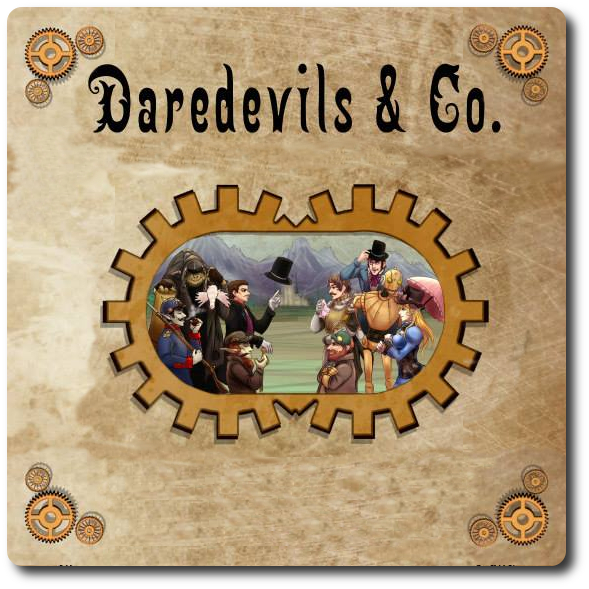
The Basics:
- For ages 9 and up (publisher suggests 12+)
- For 2 to 8 players
- Variable game play length
Geek Skills:
- Active Listening & Communication
- Counting & Math
- Logical & Critical Decision Making
- Pattern/Color Matching
- Strategy & Tactics
- Risk vs. Reward
- Cooperative & Team Play
- Hand/Resource Management
- Bluffing and Misdirection
Learning Curve:
- Child – Easy
- Adult – Easy
Theme & Narrative:
- Command your faction to victory!
Endorsements:
- Gamer Geek rejected!
- Parent Geek mixed!
- Child Geek rejected!
Overview
What every warmongering faction leader nowadays wants is some sort of stronghold. Of course, the demand for such things far outweighs the current supply. This means that you and your fellow warmongers will have to compete to claim your ideal highly secured and heavily fortified piece of real estate. To assist you are all your underlings and a strange supply of special equipment. Lead your troops well and you’ll be the envy of your peers…if any survive, that is.
Daredevils & Co, designed by Artur Zarczynski and published by the Game Crafter, is comprised of 8 Faction cards (4 on the “Dark Side” and 4 on the “Bright Side”), 10 Fortress cards, 64 War cards, and 26 Special cards. The cards are as thick as your standard playing card and just as durable. The artwork, by Emilia Goral, is excellent, blending high fantasy with Victorian steampunk. A combination that I have never seen before and strangely works.
Game Set Up
To set up the game, first separate the cards by type. Make a pile for the Fortress cards, the War cards, the Special cards, and the Faction cards.
Second, select which of the 10 Fortress cards you want to play with for the game. Fortress cards come in 3 different values. These are “Gigantic” Fortress cards (worth 15 points), “Mighty” Fortress cards (worth 10 points) and Fortress cards (worth 5 points). These will be the locations the players will be fighting for and defending throughout the game. You are welcome to play with all 10 Fortress cards or as few as 1. The number of Fortress cards you select to play with will not impact the game play length. Place the selected Fortresses cards in a row, face-up, in the middle of the playing area and within easy reach of all the players.
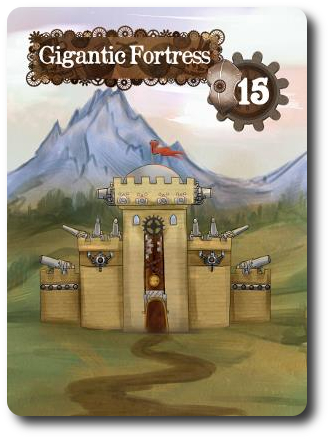
Example Fortress card
Third, take the Faction cards and divide them into two different groups. A “Dark Side” (colors red, violet, brown, and grey) and a “Bright Side” (colors yellow, orange, green, and blue). Divide the players up into even teams and make sure there is a “Dark Side” color for every “Bright Side” color. At this point, you can either allow players to make their own teams or shuffle the Faction cards and deal them out randomly to determine the teams. If the number of players is odd, teams are not possible. The Faction card dealt or selected by the player is placed in front of them, face-up. Any Faction cards not used are placed back in the game box.
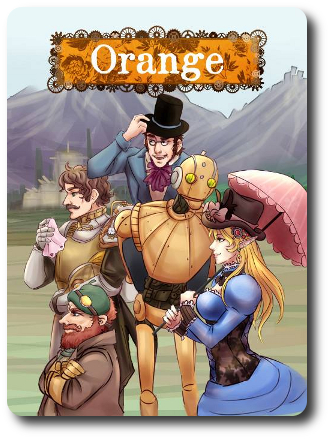
Example Faction card
Fourth, take the War cards and remove any Faction colors NOT represented by the Faction cards in front of the players. The removed War cards are placed back in the game box. Place the remaining War cards to one side.
Fifth, shuffle the Special cards and deal 3, face-down, for every player in the game. For example, you would deal 12 Special cards if playing a 4-player game. Any Special cards not dealt are returned to the game box.
Sixth, shuffle the Special cards and War cards together to form one deck. Deal out to each player 11 cards, face-down. This is the player’s starting hand. Players should look at their cards, but keep them hidden from their opponents at this time.
This completes game set up. Time to continue the great battle between darkness and … err … brightness.
Siege Warfare
Daredevils & Co is played in sieges and rounds. There are no set number of sieges in a single game, but each siege has a total of 11 rounds. Most games contain at least 2 sieges. Players should determine how many sieges will be played BEFORE they begin the game.
The first siege sets the stag for the rest of the game, but is played slightly differently than all subsequent sieges. Since none of the players own the Fortress cards, everyone is fighting for them.
Step 1: Select 3 Cards
From the hand of cards the players have, they select 3 to hold. Any remaining cards are placed face-down and given to the opponent to the player’s left (passing clockwise). Players should attempt to select colors that belong to their faction if they can, but should also attempt to NOT pass powerful cards to their opponents. Of course, there is wisdom in selecting an opposite faction’s color, too, since that limits possible card plays in the near future. If the player has any Special cards, they can choose to keep any number of them in their hand, as long as the total number of cards they keep is no more than 3.
As the game progresses, the players will be passing fewer and fewer cards to the left, but they always keep 3. Eventually, no cards will be passed and the players will be stuck playing the 3 cards they have left in their hand. In this way, players are given the ability to plan ahead.
Step 2: Attack
From the 3 cards the player elected to keep, they must play 1 to any of the Fortress cards. There are two types of cards the player can place. These are War cards and Special cards.
War cards provide an attack and defense strength value. These are used when determining who wins Fortress cards. War cards can be further strengthened by Special cards, mercenaries (that give bonuses to the War card they are attached to), and heroes who give all the War cards they are next to a bonus.
War cards have number value on the top and bottom of the card. When a player uses a War card that belongs to their faction, they always use the top side (the numbers next to the War card’s name). If a player uses an opponent’s faction, they must rotate the card and use the bottom values. Caution should be taken at this point since the same War card types across the different factions do not share the same attack and defense values. A player can always play an opponent’s faction to support their attack and defense of Fortress cards, but doing so opens the player to cards that swap sides, flip values, and other nasty surprises.
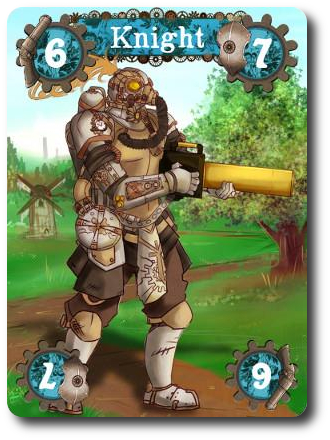
Special cards also have 2 sides and allow the player to decide how best to use the Special card to benefit themselves and their faction. Take, for example, the “Stinky Bomb / Witchery” Special card. If the player elects to play the “Stinky Bomb”, it destroys all War cards (regardless of faction) except for “Goblin” and “Dwarf” War cards. That’s pretty devastating for everyone involved, unless the player has purposely been holding and playing only “Goblin” and “Dwarf” War cards on purpose. In which case, it’s a very effective way to remove a lot of War cards with very little effort.
If the player elects to play “Witchery”, all the War cards except for “Goblin” and “Dwarf” War cards are removed from the opposing faction. For example, if the player was part of the Dark Side, all the Bright Side War cards (except for “Goblin” and “Dwarf” War cards) would be removed. If the player is working towards an end goal of total faction victory, this might be a better use of the Special card.
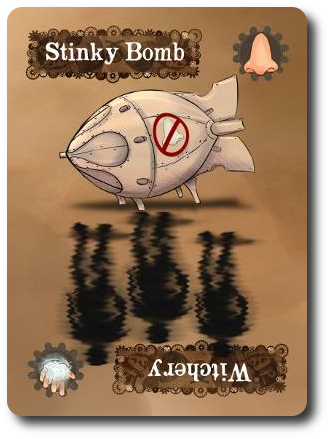
Note that there is no limit to the number of War and Special cards that can be played to any Fortress card.
Step 3: Claim Fortresses
After all the cards have been played (11 in total), the players determine who wins the Fortress cards. This is done in two stages.
- If 2 or more factions are attacking the same Fortress card, this is referred to as an “assault”. The attack values of the factions are calculated and compared. The faction with the highest attack value wins and all remaining cards are removed from the Fortress card.
- If only 1 faction is attacking a Fortress card or the assault has been completed, the next thing to determine is if the Fortress defends against the attack. This is referred to as “storming”. During the first siege of play, the player who won the assault automatically wins the storming of the fortress (no one is defending it). If it’s being defended, the player who is attacking compares their total attack value to the player who is defending. The defending player counts their defense values on their cards, not the attack value. The player with the highest takes the Fortress card.
Players who win Fortress cards place them in front of them. They now own the Fortress card and its point value. If there are more sieges to be played, the player will now be spending their time not only attempting to take new Fortress cards, but also defending the ones they have won.
This ends the first siege.
Continuing the Game
A new siege now begins by taking all the War and Special cards, shuffling them, and dealing out a new hand. Game play continues as described above except for one minor change. If a player owns a Fortress, it can now be attacked and defended. The side of the Fortress card that is closes to the owning player is the defending side (behind the fortress walls, if you like). Any attacks on the Fortress card are on the opposite side.
The End of the War
The game does not end until the agreed upon endgame condition has been met. If playing without teams (but you always still play with factions), then the first player to control so many Fortress cards or so many points from Fortress cards wins after the completion of a siege. This is referred to as “Deathmatch”, since no one is working together. Alternatively, players could organize themselves into teams (Dark Side versus Bright Side) and work together to achieve the same goal. In which case, the points or total number of Fortress cards are counted for an entire team instead of just one person.
To learn more about Daredevils & Co, visit the game’s web page. Additional details can also be found on Facebook.
Prediction
This game looks very interesting right from the start. The artwork is intriguing and I hope the game’s theme and narrative is played out on the table instead of just looking good. I like the idea of a high fantasy Victorian steampunk battle, as I’ve never actually seen any such theme in a game before. There’s a “Troll” War card, for example, that shows a giant of a monster lumbering forward and holding a cannon like it was a handgun. Awesome.
The method of calculating the attacks and defense doesn’t appear to be difficult, but the rule book is a bit difficult to follow at times. To be honest, I’m not 100% certain we are going t play the game right, but we’ll remain consistent with our rules. Unless, of course, we come across something that is blatantly wrong.
My only real concern is the Special card abilities and the game’s overall length of play. The players are going to need to consult the rule book a great deal until they are familiar with the game. Nothing on the Special cards suggests what it can or cannot do. The game’s pacing is going to suffer a bit from this, since we are going to need to pause the game, read the book, and then decide if we want to play the card or not. The game’s overall play length seems a bit long, too. I would have thought that this would be a fairly quick game, but there must be a lot more going on during the siege than what I am assuming based on the game rules.
Overall, I think the game is going to get mixed reviews. Its game play is pretty casual, but it’s a long game to play out. The Child Geeks are going to enjoy the game’s theme and narrative. Attacking and defending fortresses sounds like something they are really going to enjoy. The Parent Geeks don’t mind themed games one bit, and card games always resonate well. The Gamer Geeks will enjoy the card drafting mechanic and the way the cards can be used in different ways.
Teaching Daredevils & Co is best done by explaining how a War card works during an assault and storming a Fortress card. The entire game revolves around these two final calculations at the end of the siege. If players don’t understand how cards are counted, they will most likely mess up and be a bit disappointed.
And so, after explaining the game to my oldest little geek, I asked him his thoughts on the game so far.
“I really like what the game looks like and it sounds like a neat idea.” ~ Liam (age 9)
It does sound like a neat idea. I’m excited to give it a try. Let’s play Daredevils & Co and see if my enthusiasm is well rewarded.
Final Word
The Child Geeks we played the game with understood how the game was played, but never really found their footing. Instead, they spent the majority of the game suffering from analysis paralysis. This was a surprise to me since they only ever had 3 cards to play with. What I didn’t take into account was the selection of those 3 cards and then the time it took the Child Geeks to look over the entire table to determine which of their 3 cards they wanted to play. According to one Child Geek, “I understand how to play, but I’m finding it really hard to know what I should play.” Another Child Geek said, “This game is sooooo frustrating! I don’t know if I am playing it right or not.” And finally, one very bored Child Geek said, ‘This game is taking for-ev-er!” It’s worth noting that we only played 2 sieges. When all the games were over, the Child Geeks voted to reject Daredevils & Co.
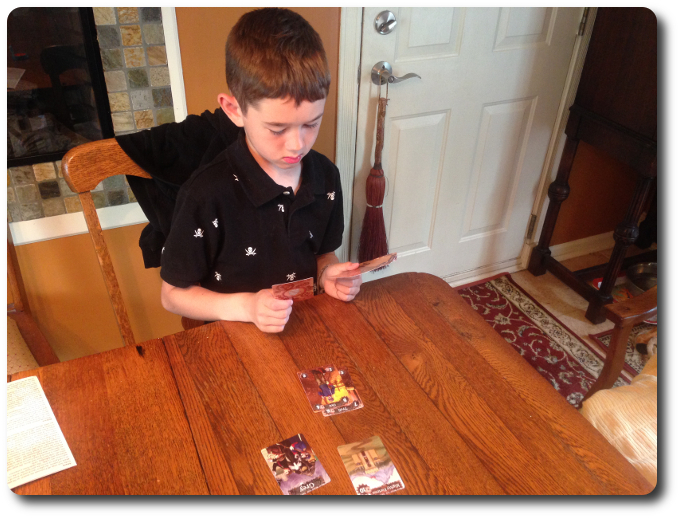
My little geek considers how best to defend his fortress from my bloodthirsty Bright Side warriors
The Parent Geeks did much better, but still suffered from analysis paralysis at times. According to one Parent Geek, “This is a surprisingly difficult game to play well. Easy to learn, but I know I am taking forever to play a card.” The difficulty is not in the game play itself, but the inability to see a siege’s outcome until it starts getting towards the 10th and 11th card. Until then, players are essentially skirmishing until it comes time for the final thrust of the attack. This was not lost on the Parent Geeks. According to one player, “I really like this game, but think it’s a bit long for new players. I’d play it with good friends, though, and those who I know who like longer games.” This sentiment was agreed upon by the majority, but the end result was still mixed from the Parent Geeks. Some thought the game was needlessly long and complicated, while others thought the game was prefect as it was.
The Gamer Geeks were as excited as I was when I first introduced the game. Their excitement began to dwindle as the games were played out. After the first siege was over, one of the Gamer Geeks looked at their iPhone and said, “That took way too long.” We tried to make the second siege go faster, but we just couldn’t do it. According to one Gamer Geek, “The game has some good ideas, but feels unbalanced and a bit loose. It needs to be tightened and refined.” Another Gamer Geek said, “I think this is a classic example of a game designed by someone who really likes it, knows it really well, and can no longer see any fault in it. And there is plenty of fault in this game.” When I pressed for specifics, he said, “It’s too long, it’s unbalanced, and I hate, hate, hate referring to the rule book – which, by the way, is not easy to read.” When all the games were done, the Gamer Geeks voted to reject Daredevils & Co. They found it to be too long and too unorganized at times to warrant space at their gaming table.
There were many aspects to this game that I enjoyed. I liked how combat was played out and how players kept their Fortresses, but were then tasked to defend them. I liked how every card could be used, even if it wasn’t your faction. I also liked how you could set up a siege to do some nasty combos with Special cards. Took awhile to set them up, but the payoff is pretty huge.
What I didn’t care for was the game’s overall play length. Playing this game with anymore than 4 players is a bit of pain. With only 2, and the game is pretty worthless. I have yet to play the game with anyone that didn’t result in overly long player turns. It does improve, however, but only after you’ve put a lot of time in the game.
Personally, I liked Daredevils & Co. I agree with the majority of our players, but I don’t think Daredevils & Co is a bad game. A bit too long at times and I want to re-write the rules (which I most likely will) to clean up some of the ambiguous wordage, but it’s an enjoyable game. My only worry now is finding other people I can play it with. But that’s never been a problem…
If you like card games that require you to think ahead and make choices on the fly, contain a good mix of luck and skill, and display some excellent artwork, do give Daredevils & Co a try. It’s got a character all its own. Far from perfect, but worth your time.
This game was given to Father Geek as a review copy. Father Geek was not paid, bribed, wined, dined, or threatened in vain hopes of influencing this review. Such is the statuesque and legendary integrity of Father Geek.




After considering the most serious allegations against D&C 🙂 we have decided to introduce the changes and facilitations. In the new version the Special Cards have brief description of how to use them, what should speed up the game play and remove the inconvenience of looking into the manual over and over again. Moreover, we have added a sheet with points tables, that first needs to be copied, cut up and lay down next to each of the fortresses. Then you can use them to sum up the points for each of the players for every fortress, and update after each move. Thanks to this you do not need to continuously count the points in memory and instead focus on tactics. New solutions should significantly speed up the game play and eliminate the problem of excessive decision-making process. All changes are ready in version 1.2 already in the TGC shop. You can also download points tables sheet from there and print at home.
https://www.facebook.com/DaredevilsandCo